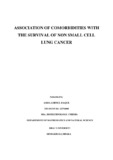| dc.contributor.advisor | Hussain, Professor Naiyyum Choudhury | |
| dc.contributor.advisor | Akram, Professor Dr.Syed Md. | |
| dc.contributor.author | Haque, Asma Aminul | |
| dc.date.accessioned | 2015-05-26T04:48:32Z | |
| dc.date.available | 2015-05-26T04:48:32Z | |
| dc.date.copyright | 2014 | |
| dc.date.issued | 2014-12-01 | |
| dc.identifier.other | ID 12376008 | |
| dc.identifier.uri | http://hdl.handle.net/10361/4148 | |
| dc.description | This thesis report is submitted in partial fulfillment of the requirement for the degree of Masters of Science in Biotechnology, 2014. | en_US |
| dc.description | Cataloged from PDF version of thesis report. | |
| dc.description | Includes bibliographical references (page 48-53). | |
| dc.description.abstract | Lung cancer constitutes the major mortality in the world and incidence of the disease varies
considerably among different ethnic population throughout the world. Palliative
chemotherapy has been a choice in advance Non-Small Cell Lung Cancer NSCLC as it has a
better result than best supportive care (BSC). The Primary objective of the present study was
Co morbidity analysis in patients with lung cancer and the secondary objective was to see the
impact of co morbidity on survival of lung cancer (NSCLC) patients. This was a retrospective
observational study. This study was carried out in the Department of Oncology at Ahsania
Mission Cancer Hospital, Mirpur, Dhaka. This study was carried out during the period from
January 2013 to December 2013 for one year of enrollment with a follow up of 6 months up
to June 2014 which makes total study period of 18 months. All patients with an age above 18
years of both sexes presented with histologically confirmed stage IIIA, IIIB & IV NSCLC
(Non Small Cell Lung Cancer) were enrolled in the study. Patient‟s data were collected from
the indoor and outdoor medical records of the AMCH hospital. After selection, patients were
divided into comorbid and non comorbid group. Comorbidity was defined by any associated
disease except for cancer. For the Kaplan Meier survival analysis patients were contacted
over the phone to see the status (Dead or Alive) on the last day of the study (2014). Total
number of patients in this study was 100 with median age of 60. The numbers of patients
suffering from Squamous cell carcinoma is 53 patients whereas that for adenocarcinoma is 47
patients. 49 patients were at stage IIIA/IIIB and 51patients were at stage IV. In the comorbid
arm 30% patient have hypertension (HTN) followed by diabetes mellitus (DM) 22% and
18% patient have both HTN and DM. Non Co morbid arm has median survival of 12.788
months (95% CI: 7.5 – 18.06) and Co Morbid has 8.0 months (95% CI: 6.81 – 9.18) and the
difference is statistically Significant (P < 0.05). According to the stratified histology than
there is a statistically superior survival in Non Co-Morbid Adenocarcinoma 10.42 months
than Co – Morbid Adenocarcinoma 8.0 months with a P value of 0.05. In stage IIIA/IIIB non
co-morbid patients have 15.45 months and co-morbid patients have 9.0 months of median
survival with a non significant difference. Younger patients (below 60 group) have median
survival of 7.25 and 8.0 months in Non co-morbid and co-morbid group respectively. But
older Non comorbid patients (above 60 group) the survival time of 14.36 months was almost twice than that of Co-morbid patients 7.02 months and the difference is statistically
significant (P<0.05).
Patients with Diabetes Mellitus tend to live longer (Median OS 12.0 months 95% CI 2.3 -
21.6) than the patients with Hypertension (Median OS 7.4 months 95% CI 2.0 -12.78). This
difference in survival is statistically significant (P < 0.05). We have observed that 68% of
patients were alive less than a year. One year survival was observed in 27% of cases whereas
two year survival was observed in 5% of overall population. Co-morbid patients had low
survival months. Among 50 co-morbid patients 39 have survived less than a year, 9 patients
have survived 1 year and only 2 have survived 2 year. A higher survival rate is observed in
Non co-morbid patients. One year survival was observed in 18 patients and 2 year survival
was observed in only 3 patients in Non co-morbid group. 29 Non co-morbid patients were
found in the group of less than a year survival which indicates a lesser mortality rate than comorbid
patients. The study revealed that co morbidity is strongly associated with the survival
of Non Small Cell Lung Cancer patient in Bangladesh. Even co morbid elderly people are in
greater risk of mortality. | en_US |
| dc.description.statementofresponsibility | Asma Aminul Haque | |
| dc.format.extent | 56 pages | |
| dc.language.iso | en | en_US |
| dc.publisher | BRAC University | en_US |
| dc.rights | BRAC University thesis are protected by copyright. They may be viewed from this source for any purpose, but reproduction or distribution in any format is prohibited without written permission. | |
| dc.subject | Biotechnology | en_US |
| dc.title | Association of comorbidities with the survival of non small cell lung cancer | en_US |
| dc.type | Thesis | |
| dc.contributor.department | Department of Mathematical and Natural Science, BRAC University | |
| dc.description.degree | M. Biotechnology | |

